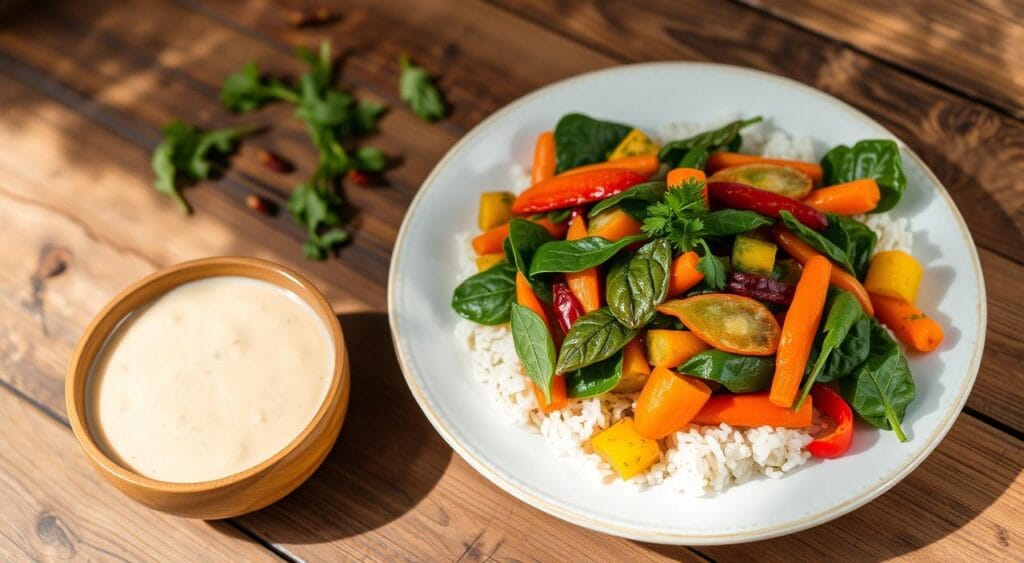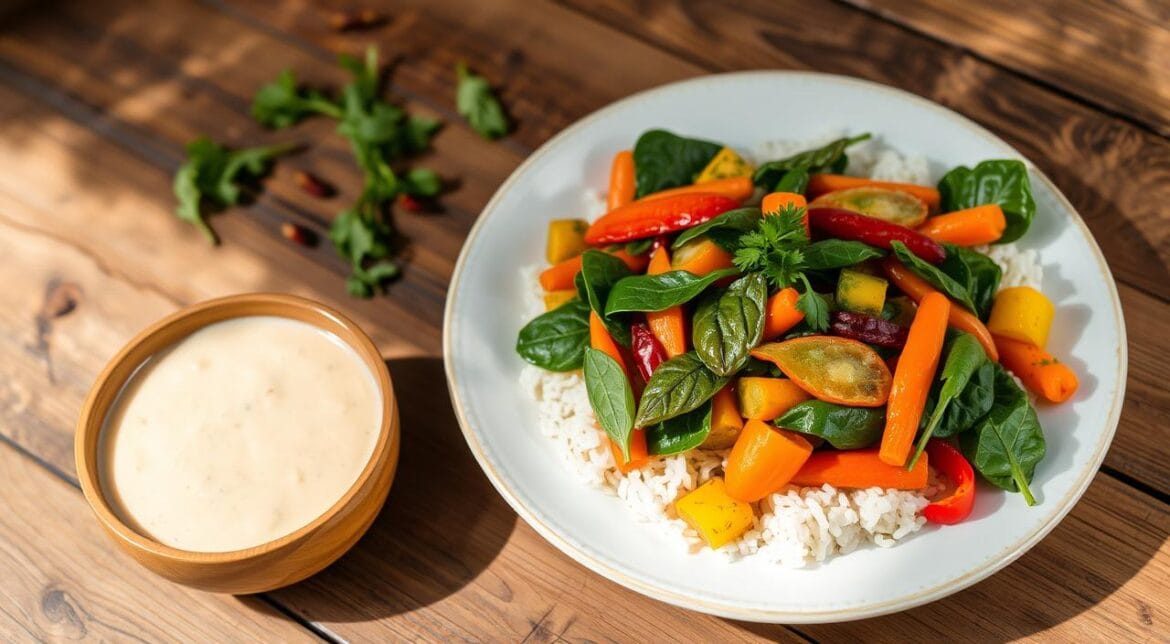Table of Contents
Learn how to make the perfect Sajata, a healthy Middle Eastern dish. It’s not only delicious but also beneficial for your health. This guide will show you the real Sajata recipe and key cooking tips to improve your cooking.
You’ll learn how to pick the best ingredients, balance flavors, and make cooking easier. Get ready to become a pro at making Sajata, from choosing the right ingredients to perfecting the taste.

Key Takeaways
- Understand the cultural significance and traditional methods of Sajata cooking
- Learn to identify and source the essential ingredients for a flavorful Sajata dish
- Discover the must-have kitchen equipment and tools to ensure Sajata cooking success
- Explore healthy ingredient substitutions and time-saving preparation techniques
- Master the art of spice blending for a harmonious balance of flavors
- Avoid common mistakes and pair your Sajata with complementary dishes
- Adapt the Sajata recipe to accommodate various dietary restrictions
Understanding the Essence of Sajata Cooking
Sajata is a special part of Middle Eastern cuisine. It’s a mix of flavors, techniques, and cultural importance. Exploring this dish reveals a deep history and modern twists that make it beloved.
Origins and Cultural Significance
The roots of sajata lie in the Middle East’s lively kitchens. It’s a key part of family and community life. The dish combines spices, herbs, and ingredients, showing the region’s culinary heritage.
In places like Cairo and Beirut, sajata’s smell fills the air. It invites everyone to enjoy Middle Eastern cuisine. This dish goes beyond cooking, symbolizing culture, shared moments, and community bonds.
Traditional vs Modern Approaches
As the world changes, so does sajata cooking. Traditional methods and recipes are still key, but modern cooks also experiment. They adapt sajata to today’s tastes and diets.
Now, you can find new sajata versions. From cajun shrimp pasta to blackened shrimp linguine, it’s reimagined in many ways. Yet, it always stays true to its Middle Eastern cuisine roots.
“Sajata is not just a dish – it’s a tapestry of flavors, a celebration of cultural identity, and a testament to the enduring power of culinary traditions.” – Chef Amira Khalil
Discovering sajata takes you on a rich culinary journey. It connects past and present, generations and cultures, through food.

Essential Ingredients for the Perfect Sajata Recipe
Making a true new orleans shrimp pasta or creole shrimp pasta needs careful picking of authentic sajata ingredients. You need aromatic spices and fresh seafood. Each part is crucial for the Cajun dish’s flavor. Let’s look at the main ingredients that make Sajata stand out.
Essential Spices and Herbs
The heart of Sajata is a mix of spices that add depth to each bite. The key spices are:
- Paprika (smoked or sweet)
- Cayenne pepper
- Garlic powder
- Onion powder
- Dried thyme
- Dried oregano
- Black pepper
Aromatic Vegetables
The “holy trinity” of Cajun cooking – onions, bell peppers, and celery – are the base of Sajata. These veggies add texture and aroma, making the dish rich and flavorful.
Protein Options
Shrimp is the main protein in Sajata, but you can try other seafood like crawfish or andouille sausage. Make sure the protein is fresh and goes well with the other ingredients.
| Ingredient | Importance | Substitutions |
|---|---|---|
| Shrimp | The star of the dish, adding juicy texture and briny flavor. | Crawfish, andouille sausage, chicken |
| Tomatoes | Provide acidity and depth to the sauce, balancing the spices. | Canned diced tomatoes, tomato paste |
| Rice | The perfect base to soak up the rich, flavorful sauce. | Cauliflower rice, quinoa, or pasta |
The secret to a great Sajata dish is using high-quality ingredients in the right balance. Experiment with different combinations to discover your favorite.
Kitchen Equipment and Tools You’ll Need
To make the perfect spicy shrimp pasta, you need the right cooking utensils and kitchen equipment. We’ll look at the basics and some extra tools that can help. These are key for your Sajata cooking journey.
Must-Have Cooking Utensils
- A sturdy chef’s knife for chopping veggies and slicing proteins
- A cutting board for a safe, stable prep surface
- A wooden spoon or silicone spatula for stirring and serving
- A ladle for portioning your Sajata dishes
- A colander to drain pasta or veggies
- A set of measuring cups and spoons for precise ingredient amounts
Optional but Helpful Tools
While the basics are enough to start, adding these kitchen equipment pieces can make cooking easier:
- A food processor or blender for mixing spice blends and sauces
- A vegetable peeler for quick prep of ingredients like ginger or carrots
- A garlic press to easily mince garlic
- A microplane grater for zesting citrus or grating spices
- A cast-iron skillet for searing proteins and veggies to perfection
With these cooking utensils and kitchen equipment, you’ll be ready to master Sajata cuisine. Choose quality tools that will last. Your spicy shrimp pasta and other Sajata dishes will appreciate it.
“The right tools can make all the difference in the kitchen, transforming a good dish into a great one.”
Preparing Your Workspace for Sajata Success
Mastering louisiana shrimp pasta starts with a tidy kitchen. Mise en place helps you cook better and feel less stressed. This way, you can make tasty sajata dishes without a hitch.
A clean kitchen is key. First, get all your ingredients and tools ready. Put your spices, chopped veggies, and prep items in order. This makes cooking smooth and easy.
- Get storage containers and labels for your pantry and fridge. This keeps things neat and handy.
- Use your walls for shelves or racks. This saves space and keeps things within reach.
- Put similar things together. This makes your workflow faster and more efficient.
Mise en place is a French term for “everything in its place.” Prepping all your ingredients before cooking makes a big difference. It boosts your cooking speed and success.
| Mise en Place Step | Benefits |
|---|---|
| Measure and chop ingredients | Reduces the risk of forgetting or misusing ingredients during the cooking process |
| Arrange tools and equipment | Ensures everything you need is within reach, minimizing distractions and interruptions |
| Clean and organize work surfaces | Provides a clean, clutter-free environment to work in, promoting better focus and efficiency |
With these kitchen organization and mise en place tips, you’re set for sajata cooking success. You’ll make delicious dishes with confidence and ease.
Mastering the Art of Spice Blending
Improving your southern shrimp pasta dishes starts with spice blending. It’s an art that needs practice and trying new things. By getting good at spice blending, you can make your sajata recipes taste amazing.
Creating Balanced Flavor Profiles
Creating balanced flavors is all about mixing spices right. Some spices, like cumin and coriander, go well together. But others, like cloves and cinnamon, can take over if you use too much. Try different mixes and amounts to find the perfect balance for your southern shrimp pasta.
To get a great flavor, mix spices that offer different tastes. Use aromatic, warm, earthy, and bright spices. This mix will add depth and complexity to your dish, making everyone talk about your spice blending skills.
Storage and Shelf Life Tips
Keeping your spice blends fresh is key. Store them in tight containers, away from sunlight and heat. This keeps their flavor profiles strong and vibrant for longer.
Whole spices usually keep their flavor longer than ground ones. Grind your spices just before using them for the best taste. Always check the expiration dates on your spice jars and replace old ones.
“The art of blending spices is a dance of flavors, where each ingredient plays a vital role in creating a harmonious, unforgettable dish.”
Healthier Ingredient Substitutions
Cooking a delicious sajata recipe doesn’t mean you have to give up nutrition. A few simple swaps can make your dish healthier without losing flavor. Let’s look at some healthy alternatives to make your sajata more nutritious.
Whole Grain Goodness
Choose whole grains like brown rice or quinoa instead of white rice. They offer more fiber and complex carbs. Plus, they add a nutty taste and texture to your sajata recipe.
Lean Protein Choices
Switch to lean proteins like chicken breast, turkey, or tofu for a protein boost. This change cuts down calories and fat but keeps your dish nutritious.
Veggie Variety
Add a variety of vegetables to your sajata recipe. Try sautéing spinach, bell peppers, or zucchini. These healthy alternatives add fiber, vitamins, and minerals, making your meal more nutritious.
| Ingredient | Healthier Alternative | Nutritional Benefits |
|---|---|---|
| White Rice | Brown Rice or Quinoa | Increased Fiber, Complex Carbohydrates, and Nutrients |
| High-Fat Meat | Lean Chicken, Turkey, or Plant-Based Protein | Reduced Calorie and Fat Content, Higher Protein |
| Limited Vegetables | Spinach, Bell Peppers, Zucchini | Enhanced Fiber, Vitamins, and Minerals |
By choosing these healthy alternatives for your sajata recipe, you can enjoy great taste and nutrition. Experiment to find the perfect mix of flavor and health for you.
Time-Saving Preparation Techniques
Cooking a tasty cajun shrimp pasta can take a lot of time. But, with smart preparation, you can make it quicker. Learn how to prep efficiently for your sajata recipes.
Meal Prep Strategies
Meal prepping is an excellent way to save time in the kitchen. Start by making parts like the cajun spice blend, chopped veggies, or pre-cooked shrimp ahead of time. This way, you can quickly put together your cajun shrimp pasta when it’s time to eat.
Also, think about freezing things like the spice blend or pre-cooked proteins. This keeps them ready for when you need them.
Quick Assembly Methods
For efficient cooking, being organized is crucial. Set up your workspace so everything you need is right there. This makes it easy to add each part to your dish.
Try cooking techniques like sautéing veggies and shrimp at the same time. This makes assembling your dish even quicker.
Using these quick prep methods can make cooking cajun shrimp pasta easier. Focus on meal prep and quick assembly to make weeknight meals simpler. This way, you can enjoy your meal more without the stress of long cooking times.
Common Mistakes to Avoid in Sajata Cooking
Mastering Sajata cooking takes time and practice. Knowing common mistakes helps avoid disappointing results. Whether making blackened shrimp linguine or other Sajata dishes, proper technique is key to delicious food.
One big mistake is overcooking proteins. Sajata dishes have delicate flavors. Overcooked meat, seafood, or tofu can make them taste bitter or rubbery. Keep an eye on cooking times and temperatures to avoid this.
Another mistake is not balancing seasonings. Sajata cuisine needs a perfect mix of spices and aromatics. Too much or too little of an ingredient can mess up the dish. Taste and adjust seasonings as you go.
- Avoid overcooking proteins
- Ensure proper seasoning balance
- Measure ingredients accurately
- Maintain appropriate cooking temperatures
- Allow sufficient resting time before serving
By avoiding these mistakes and following best practices, you’ll make amazing Sajata dishes at home.
| Common Sajata Cooking Mistakes | Troubleshooting Solutions |
|---|---|
| Overcooking proteins | Monitor cooking times and temperatures closely |
| Imbalanced seasoning | Taste and adjust seasonings throughout the cooking process |
| Inaccurate ingredient measurements | Use precise measuring tools and follow recipes closely |
| Incorrect cooking temperatures | Invest in a reliable digital thermometer to ensure proper heat levels |
| Insufficient resting time | Allow dishes to rest for a few minutes before serving to allow flavors to meld |
“The key to perfect Sajata cooking is paying attention to the details. By avoiding common mistakes, you’ll unlock the true essence of this flavorful cuisine.”
Pairing Your Sajata with Complementary Dishes
Enjoying a sajata dish is even better with the right sides and drinks. From classic dishes to cool drinks, find the best matches for your new orleans shrimp pasta.
Side Dish Recommendations
Balance the richness of your sajata with light, tasty sides. A crisp garden salad with zesty dressing is refreshing. Roasted veggies like asparagus or bell peppers add color and texture.
For something heartier, try steamed basmati rice or garlic naan bread. They soak up the sajata sauce nicely.
Beverage Pairings
There are many drinks to enhance your sajata meal. A chilled white wine, like Sauvignon Blanc or Pinot Grigio, pairs well with the spices. For a casual choice, a light lager or iced tea works great.
If you don’t drink alcohol, mango lassi or cucumber-mint cooler are perfect. They contrast nicely with the savory pasta.
“The right side dishes and beverages can transform a good sajata into an unforgettable culinary experience.”
Storage and Reheating Guidelines
Storing and reheating your creole shrimp pasta right is key to keeping its great taste and texture. Use these tips to maintain the freshness and flavor of your leftovers.
Storing Leftover Sajata Dishes
To keep your creole shrimp pasta at its best, store it correctly. Store leftovers in an airtight container in the refrigerator within 2 hours of cooking. Cooked pasta and seafood should be eaten within 3-4 days for the best taste and safety.
For longer storage, freezing your sajata dishes is a good choice. Put the pasta and sauce in freezer-safe containers or bags, leaving some space for expansion. Frozen, your creole shrimp pasta can last up to 3 months.
Reheating Leftover Sajata
Ready to enjoy your leftover sajata? Here’s how to reheat it to bring back its flavor and texture:
- Microwave: Put the pasta in a microwave-safe dish, add a bit of water or broth. Reheat in 30-second intervals, stirring often, until hot.
- Stovetop: Reheat the pasta in a skillet over medium heat, adding liquid as needed to prevent drying.
- Oven: Preheat to 350°F (175°C). Put the pasta in an oven-safe dish, cover with foil, and reheat for 15-20 minutes, or until hot.
Stir the pasta often, no matter the reheating method. Avoid overcooking to keep its best texture.
| Food Storage Guideline | Refrigerator (40°F or below) | Freezer (0°F or below) |
|---|---|---|
| Cooked Pasta Dishes | 3-4 days | 2-3 months |
| Cooked Seafood Dishes | 3-4 days | 2-3 months |
Enjoying your leftover creole shrimp pasta depends on proper storage and reheating. By following these guidelines, you can enjoy its delicious flavors for a long time.
Adapting Sajata for Dietary Restrictions
The spicy shrimp pasta dish, Sajata, is loved by many. But, it’s important to make it accessible to everyone. This means making it gluten-free and vegetarian friendly. With a few tweaks, this traditional recipe can be enjoyed by all.
Gluten-Free Modifications
For those who must avoid gluten, Sajata can be made gluten-free. Just swap the regular pasta for gluten-free options. Here are some great choices:
- Brown rice pasta
- Quinoa pasta
- Lentil or chickpea-based pasta
These alternatives not only fit the gluten-free diet. They also bring new textures and nutrients to the dish.
Vegetarian and Vegan Options
For vegetarian and vegan guests, Sajata can be modified. Replace the shrimp with plant-based proteins. Here are some tasty options:
- Grilled or sautéed tofu
- Roasted mushrooms or eggplant
- Marinated tempeh or seitan
These choices not only meet dietary needs. They also add unique flavors that enhance the Sajata dish.
“Adapting traditional recipes to accommodate various dietary restrictions is a wonderful way to make delicious meals accessible to all.”
Remember these tips to make your Sajata dishes appealing to everyone. This way, your cooking can bring joy to a wide range of people.
Conclusion
Learning sajata cooking is essential for making healthy, tasty meals that show off Middle Eastern flavors. You now know the cultural importance of this old cooking method and how to mix spices just right. These insights will make you a better cook.
Whether you’re making a tasty louisiana shrimp pasta or trying new sajata recipe versions, you’re ready. The skills you’ve picked up will help you make meals that are good for you and delicious. Cooking healthily is all about trying new things and adding your own twist to old recipes.
Keep improving your sajata skills and share your cooking stories with others. This will inspire them to try this vibrant, healthy cooking style. By doing this, you’ll feed your loved ones and help keep this important cultural tradition alive. Enjoy cooking and bon appétit!
FAQ
What is the authentic sajata recipe?
Sajata is a nourishing dish from the Middle East. It combines aromatic spices, vegetables, and sometimes protein. To make it right, you need to know the key ingredients, how to blend spices, and the best cooking methods.
How can I make my sajata cooking healthier?
To make sajata healthier, try using whole grains, lean proteins, and fresh veggies. Focus on balanced flavors and good cooking techniques. This will make your dish more nutritious.
What equipment and tools do I need to prepare sajata?
You’ll need a sharp knife, cutting board, and a pan or skillet. Also, mixing bowls and a spice grinder or mortar and pestle are essential. Optional tools like a food processor or slow cooker can make cooking easier.
How can I master the art of spice blending for sajata?
Mastering spice blending for sajata means understanding flavors, ratios, and how to toast and grind spices. Good spice blending skills ensure your sajata tastes perfect.
What are some common mistakes to avoid when cooking sajata?
Avoid using wrong cooking temperatures, overcrowding the pan, and not adjusting spice ratios. Focus on timing, ingredient proportions, and cooking techniques for great results.
How can I adapt sajata to accommodate dietary restrictions?
For dietary restrictions, use gluten-free grains or pasta. Find vegetarian or vegan options that keep the traditional sajata flavors. Use whole, plant-based ingredients for inclusive dishes.
What are some recommended side dishes and beverage pairings for sajata?
Serve sajata with rice, couscous, or fresh salads. Pair it with mint tea, lemon water, or light white wines. These pairings can enhance your sajata experience.
How can I store and reheat leftover sajata?
Store leftover sajata in an airtight container in the fridge for 3-4 days. Reheat it on the stovetop or microwave. Make sure it’s hot without overcooking.

